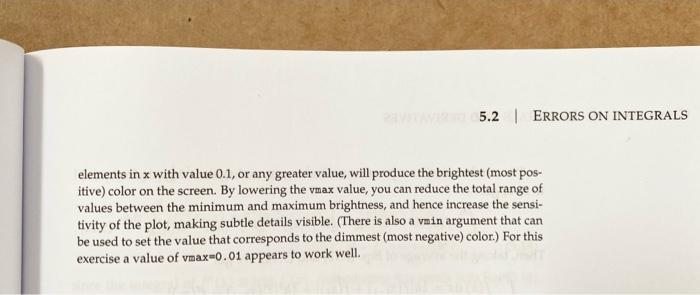Exercise 5.4 (Suggest V max = 0.005) Use Collab , and and numpy. Exercise 5.4: The diffraction limit of a telescope Our ability to resolve detail in astronomical observations is limited by the diffraction of light in our telescopes. Light from stars can be treated effectively as coming from a point source at infinity. When such light , with wavelength 1, passes through the circular aperture of a telescope (which we'll assume to have unit radius) and is focused by the telescope in the focal plane, it produces not a single dot, but a circular diffraction pattern consisting of central spot surrounded by a series of concentric rings. The intensity of the light in this diffraction pattern is given by (kr = (hrs) The diffraction pattern produced by a point source of light when viewed through a tele- scope. where r is the distance in the focal plane from the center of the diffraction pattern, k = 270/4, and (x) is a Bessel function. The Bessel functions ).(x) are given by In(x) = #S"cos(mo x sino) do, where m is a nonnegative integer and x > 0. a) Write a Python function J(m,x) that calculates the value of ).(x) using Simpson's rule with N = 1000 points. Use your function in a program to make a plot, on a single graph, of the Bessel functions Jo, J. and 12 as a function of x from x = 0 to x = 20. b) Make a second program that makes a density plot of the intensity of the circular diffraction pattern of a point light source with A = 500 nm, in a square region of the focal plane, using the formula given above. Your picture should cover values of r from zero up to about 1 jm. Hint 1: You may find it useful to know that limz+0 (x)/x = 1. Hint 2: The central spot in the diffraction pattern is so bright that it may be difficult to see the rings around it on the computer screen. If you run into this problem a simple way to deal with it is to use one of the other color schemes for density plots described in Section 3.3. The "hot" scheme works well. For a more sophisticated solution to the problem, the imshow func- tion has an additional argument vmax that allows you to set the value that corresponds to the brightest point in the plot. For instance, if you say "imshow(x, vmax-o, 1)", then 148 5.2 | ERRORS ON INTEGRALS elements in x with value 0.1, or any greater value, will produce the brightest (most pos- itive) color on the screen. By lowering the vmax value, you can reduce the total range of values between the minimum and maximum brightness, and hence increase the sensi- tivity of the plot, making subtle details visible. (There is also a vmin argument that can be used to set the value that corresponds to the dimmest (most negative) color.) For this exercise a value of vmax=0.01 appears to work well









